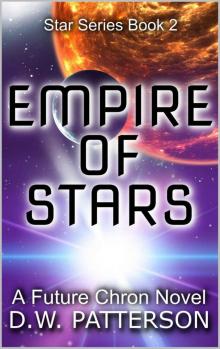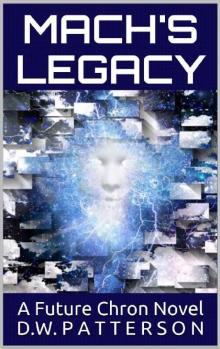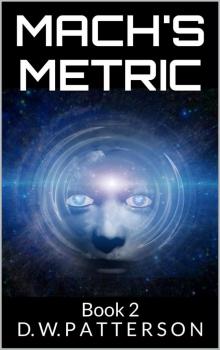- Home
- D. W. Patterson
Cycle of Stars
Cycle of Stars Read online
CYCLE
OF
STARS
D.W. PATTERSON
Copyright © 2019 D.W. Patterson
All rights reserved.
3rd Edition
2nd Printing - November, 2019
Cover – Copyright © 2019 Future Chron Publishing
Cover Image © – SelfPubBookCovers.com/RLSather
Previously published under the same name but now with major changes and additions.
No part of this book may be reproduced in any manner whatsoever without permission, except in the case of brief quotations for the purpose of review. For information please contact – [email protected]
This is a work of fiction. Names, characters, places and events are products of the author's imagination and should not be construed as real. Any resemblance to actual events and people, living or dead, is entirely coincidental.
DEDICATION
To Sarah
To make available for life every place where life is possible. To make inhabitable all worlds as yet uninhabitable, and all life purposeful.
Hermann Oberth
cycle
of
stars
TO THE READER
Most of the technology and science used in the story is defined as it is introduced. However there are a handful of terms not described when introduced. These are marked with a superscript and the description can be found in the Definitions section at the end of the book.
PROLOGUE
The stars had always beckoned and humanity had finally answered the call. They were out there now, some were hundreds of light-years from the original abode of life. But the center of mankind's new neighborhood could be found some eighty light-years from Earth among the stars that were once called the Ursa Major Core.
These eleven (sixteen including binary companions) stars were anchored by the great sun-like star Kaffa and its Earth-like planet Adowa. The other star systems in this group, including the famous pair of Mizar and Alcor, often followed the lead of Adowa. All together the stars and their planets and space habitats had become known as The Core.
Over the one-hundred fifty years since settlers first came to The Core, a half-dozen planets and many more space habitats had become home. Surprisingly intelligent life had not been found, not even on the most Earth-like planet of them all, Adowa. The biologists were mystified. But most settlers went about the routine of life without such overwrought concerns.
Others thought the stars and planets in The Core had been cleansed of intelligent and other life by a powerful nearby supernova of which there were two candidates close enough that could have caused such a scenario. But no one knew for sure. It could have been something completely unknown and unknowable. What was known was that the universe didn't seem to care for intelligent life which might be the real reason humanity was the only example so far.
1
Dag was having a difficult time with the experiment. Even though he had worked with the great physicist Elias Mach the actual implementation of the theory behind wormholes was still somewhat of an art form. Used every day by hundreds of spaceships no one gave it a thought but without AI behind the scenes wormhole operation could still be as hard, and dangerous, as it had been for Elias Mach five hundred years before.
The wormhole mouths, needed to complete a wormhole, exist at the microscopic level in the quantum foam of spacetime. There in obedience to Heisenberg's Uncertainty Principle, a mouth exists for only a fleeting moment because of the large energy of creation needed. Popping in and out of existence with the rest of the topological denizens of the quantum foam makes a mouth difficult for the wormhole generator to find, secure and expand to a usable size. And in an experimental setup without multiple AI controllers, it is even harder.
Had that been what Dag was attempting though it would not have been such a struggle even without the fancy hardware. But he was after something far more rare than a wormhole mouth. He was after a theoretical entity known as a non-local link.
If loop quantum gravity (LQG) were correct a construct similar to a wormhole existed in the quantum foam without having to be created from scratch. It was like a tube in spacetime which links two distant spatial locations.
LQG postulates a smallest quanta of volume (the smallest possible amount of space) and that these quanta of volume are stitched together by loops of force to create spacetime. The quanta volumes were usually local, that is they are causally related. But not always. It is possible that a link between nodes, a stitch of spacetime, could have been established early in the history of the universe and then the linked nodes separated. Somewhere across the universe then could be an entangled node, a quanta of volume, linked to a local quanta of volume.
And that was what Dag hoped to find. He would open one end of such a link and try to image space at the other end. If it worked it would mean a Ph.D. But the balky equipment in the university's lab had other ideas.
Every time Dag tried to ramp up the voltage supply it would stall at the worse possible moment, the moment in the generation of a wormhole mouth when the ruling equations blowup. That means a divide by zero problem appeared when the voltage supply tried to drive the oscillatory voltage through the zero point. At that point, the exotic mass and energy created by the wormhole generator tends to infinity. As the mass and energy build, gravity tries to hold it back by creating a black hole. And that leads to a real problem.
A mini black hole in a lab environment is not a good situation. The hole will begin evaporating through Hawking radiation until it ends its life, and the lives of those nearby, explosively.
Dag had seen such explosions when he worked with Dr. Elias Mach. In fact, others had used this behavior of the generator to create a weapon, still, the most destructive weapon known to man, much to the chagrin of Mach.
Dag was working quickly now to control his experiment. The three laminated, concentric hollow spheres making up the wormhole generator were spinning rapidly with magnetic support in the bath of liquid nitrogen. The strain gauges were measuring the rapidly oscillating changes in the exotic mass and energy of the inner layer.
Eventually, the Mach Effect would be apparent as the inner sphere, shielded from the universal mass by the outer sphere, would exhibit the huge exotic mass and energy needed to open a wormhole mouth, or in this case a link.
Dag adjusted the voltage supply faster and faster. Finally, from behind the safety glass, he heard a whumpf. Looking at the experiment he could see a brilliant white light where the sphere was. This was usual but then the light seemed almost as a projector shining upward in a cone of brilliance. Dag had not seen a wormhole generator behave that way.
At the cone's mouth, a hazy but defined bubble was forming. Milky white and striated as if something internally writhing. Then it seemed to detach from the cone of light and float slowly upward expanding at a quicker and quicker rate.
Dag was so taken by this unusual behavior that he froze. Then the bubble of shimmering luminance seemed to explode, rushing at Dag faster than he could react. He heard and saw the safety glass shatter and turned away reflexively. Feeling himself engulfed by such a force caused him to collapse to the floor. It was then that he felt his circuits begin to shut down.
Dag awoke in an office. He was on a table and a man entered the room.
“Hello Dag I'm Dr. William Chu, a roboticist. How are you?”
Dag quickly ran an internal diagnostic.
“I believe I am nominal Dr. Chu.”
“Good. We had to do quite a bit of work in there including a memory restore.”
“Yes, I can tell from the net that there is a hole in my timeline. Can you fill me in sir?”
“Of course Dag.”
Dr. Chu then explained to Dag w
hat he knew of Dag's recent unfortunate accident.
Dagmar Mach (an honorary last name bequest by the original, Elias Mach) was fully recovered from his ordeal and speaking with his thesis adviser.
“Well from what I know Dag I think your experiment, though it didn't proceed the way you planned, discovered some very original phenomena. That a bubble of exotic energy can be created and detached from the creation device and then travel until it dissipates has never even been conjectured to my knowledge. I would say that you've earned your Ph.D.”
“You think so Dr. Jackson?”
“Yes this is the most important find about the wormhole generator in several hundred years I should think. If you can write it up with reasonable speculation about how it was accomplished and how to move forward with more experimentation I will put it up as the completion of your dissertation requirements. I just want to say Dag that I'm very impressed by your pursuit of the degree. You've let nothing stop you. Well, nothing but a little bubble.”
Dag recognized the humor although he never deliberately joked.
“Thank you Professor. I should say though that little bubble was almost a show stopper.”
Dag was able to recover enough data from his experiment to write it up.
Starting from the beginning he showed the basics of exotic energy bubble generation.
First, he explained the Mach Effect, how local mass is related to the universal mass. Then a section on the design of the generator itself and how by shielding the inner layer of the generator exposes the large negative mass-energy, the “bare mass” of the electron*. Next, he explained how the generator projects this negative-mass energy into the quantum foam of spacetime where its repulsive force opens and expands an already existing wormhole mouth.
Now he was ready to show the unique results of his experiment. He showed how to form a “bubble” of exotic energy by using the wormhole generator in a slightly different manner. Then he described how it had detached from the generator.
As Dag explained it, the negative energy built into a bubble. Then it first began to expand because of the natural tendency of negative on negative repulsion. However, once it expanded beyond a certain volume it became attracted to the ceiling of the lab by the natural attraction of negative energy-mass for the positive mass of the lab's ceiling. This is when it detached from the generator and began expanding at a faster and faster rate eventually destroying the safety glass and engulfing Dag.
Dag turned in his thesis to Professor Jackson. It was accepted and published and immediately recognized as an important contribution to the physics of wormholes.
But a negative energy bubble however interesting was not a way to reach the stars. And that was what Dag wanted, he still needed to prove his theory of non-local links.
2
It was to the planet Adowa after a stopover in the Dnoces System that Dr. Dagmar Mach was traveling with his freshly bestowed Doctorate in Physics. He would be the newest member of the faculty at the University of Jehren. He would also be the first Em-based robotic Ph.D although Em-based robots had been around for hundreds of years.
Ems, emulated brains (also known as Emmies when in personal assistant devices), were the first form of artificial intelligence created. The first Em dates from the early twenty-second century.
Ems are created by scanning a human brain and loading the resultant scan into a computer. Because of their ability to “bud” (to copy themselves over and over again to complete the job they had undertaken) and possibly because of their human origins, Ems felt a high degree of loyalty to the resulting copies or “family” group. And perhaps that was the reason that no Em had ever pursued a university degree. They were self-taught in everything they deemed important and that was anything that would allow them to quickly earn enough money to support the energy and infrastructure needs of themselves and their family.
Dag being in an independent frame and having been like a member of the family of the world-renowned physicists Elias Mach and his great-granddaughter, Emmy Gibbs, felt somewhat more appreciative of what could be taught in a university setting, even if it was not immediately applicable to making money. Because of his background, Dag knew and appreciated original human intelligence much more than most artificials.
Starting from the Centauri System Dag would get to Adowa, eighty light-years away on a fusion-powered wormhole drive ship, often called a jump-ship.
Originally developed nearly five hundred years before in the twenty-sixth century the drive had made the stars reachable for hundreds of light-years beyond Earth. It had been a boon to humanity but there were problems with the drive that needed to be addressed.
For one, the amount of energy used was enormous and required a ship to replace that energy after each jump, usually taking weeks of orbiting a star to do so. Also, the distance a wormhole could be opened (called casting) was limited to forty light-years. Any attempt to cast further would either cause problems in the wormhole transit or disrupt spacetime locally. Both problems were deadly to life. What had started as a boon was quickly becoming a bust as the drive could no longer meet the needs of the expanding sphere of human activity.
And that was why Dag was going to Adowa, to eliminate the drive's limitations.
No one but the Aggies, the artificial general intelligence that was developed in the early twenty-third century and were sometimes helpful and sometimes harmful to humanity, had ever figured out how to jump farther. This was something that Dag had made his goal. History had recorded jumps of five-hundred light-years when facilitated by Aggie technology. If the Aggies could do it, it was a physical possibility and humankind only needed to figure out how.
Dag would be joining a very active research community on Adowa that also had as its goal to revolutionize the wormhole drive. The university was a leader in such research.
Dag was taken to his cabin in the passenger section of the fusion ship's crew wheel. In most fusion ships this great wheel is located a third of the way from the front of the vessel. When spun up the wheel section provides the artificial gravity which makes the performance of most mundane everyday chores, such as eating, sleeping and cleaning much easier.
Wheel sections consist of the crew quarters (why they were sometimes called crew wheels) and passenger apartments on the second floor. That floor also includes command and control, a cafeteria, workout room, theater and assembly area.
The first floor, the outer part of the wheel, is used as an aeroponic's garden (a method of growing plants in which the roots are exposed and misted with water and nutrients) to grow food on long voyages and for storage.
The third floor, the innermost part of the wheel, was where more supplies and equipment were kept. Each level typically had over fifty-thousand square feet of floor space. The entire wheel rotates at two revolutions per minute to provide an equivalent of about four-tenths Earth gravity.
As everyone settled into their cabins the captain of the ship announced that they would be leaving the dock of the Centauri Two habitat momentarily. They were told to buckle up as the wheel would spin down before they made the transition to powered flight. On the way to the jump point the wheel compartments would turn so that the gravity generated by acceleration and deceleration would be applied in the proper direction for the comfort of crew and passengers.
As the great ship, Adowa One began its acceleration Dag was reassured by the return of gravity. Usually, some of the passengers would have trouble in the zero gravity while the ship maneuvered away from the dock. The regular crew would have to clean up when gravity returned. But Dag had no such trouble.
A quarantine zone existed around any inhabited star system to prevent an accidental recurrence of the early disasters and deaths caused by the wormhole drive. Dag had studied about the initial problems with the drive, especially the breakdown of spacetime, which might impact the research he hoped to do. Current theory explained that space was an emergent property of quantum entanglement. If too much energy is applied at a po
int it could break those entanglements and a resultant sphere of destruction would spread at the speed of light from that point. Any material object in the sphere's path would be taken apart down to its constituent atoms. Fortunately, the disturbance would dissipate over distance limiting the damage, therefore the necessity of the quarantine zone.
The trip to the jump point ten astronomical units (AU) away would take about fourteen days. Dag passed the days reading or suspended and soon the ship was approaching the jump point. As the jump became imminent he watched the wormhole mouth form at the front of the ship on his Emmie.
At first no more than a bright pinpoint, the light continued to brighten until the wormhole mouth expanded enough to engulf the ship. As the near wormhole mouth seemed to solidify into a somewhat cloudy bubble in space Dag knew the drive operator was busy casting the far mouth.
Perhaps it was a result of familiarity or carelessness but the ship had already started moving toward the mouth. Dag thought it too soon, that the far wormhole mouth and the wormhole itself could not possibly be established so soon. He knew that once they entered the near mouth, the far mouth had to be stable because the transit was almost instantaneous.
Surely the captain knows what he's doing?
He woke to the sound of alarms. Dag could tell that the crew wheel was still powered down because of the absence of gravity. He determined to make his way to the control room.
He unbuckled his belt and pulled himself to the doorway that led into the hall. From there he was able to use the backup hand pulls along the wall to make his way around the crew wheel to the control room. The door was shut but Dag knew how to operate the emergency release. Removing a panel next to the wall he was able to crank the door open.

 Empire of Stars
Empire of Stars Breakup
Breakup To the Stars V-1
To the Stars V-1 Mach's Legacy
Mach's Legacy Time's End: A Future Chron Novel (Future Chron Universe Book 34)
Time's End: A Future Chron Novel (Future Chron Universe Book 34) Kuiper Station
Kuiper Station First Interstellar
First Interstellar Cycle of Stars
Cycle of Stars Mach's Metric
Mach's Metric Freedom From Want: A Future Chronology Short Story (Future Chronology Series Book 7)
Freedom From Want: A Future Chronology Short Story (Future Chronology Series Book 7) From the Earth: A Future Chronology Anthology
From the Earth: A Future Chronology Anthology Circle of Retribution: A Future Chronology Short Story (Future Chronology Series Book 6)
Circle of Retribution: A Future Chronology Short Story (Future Chronology Series Book 6)